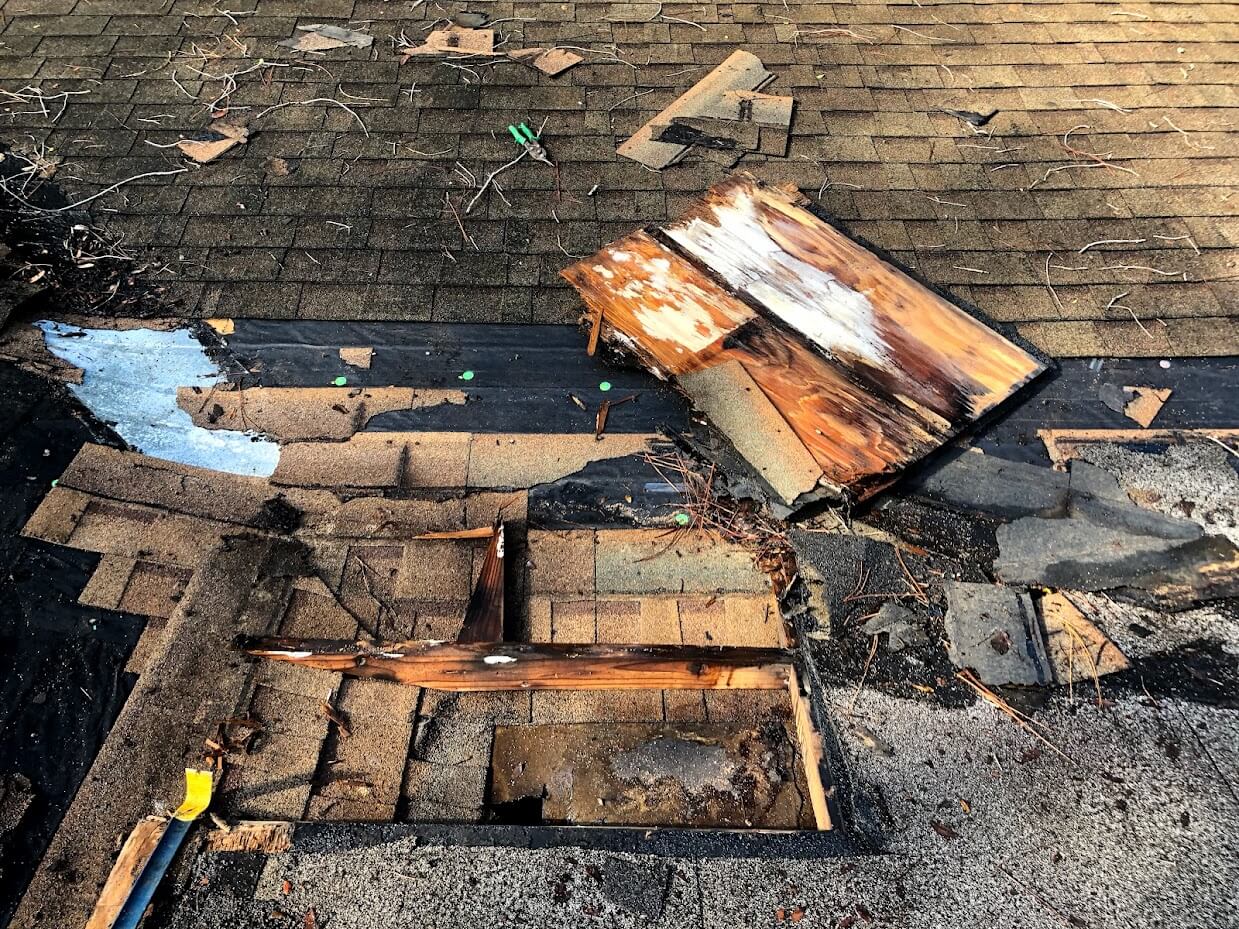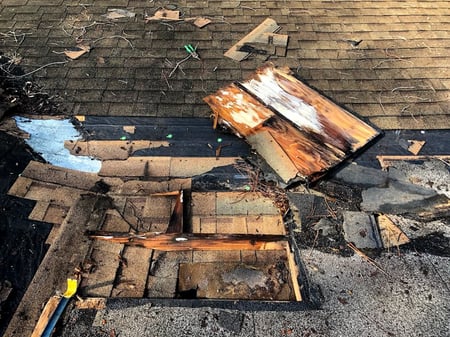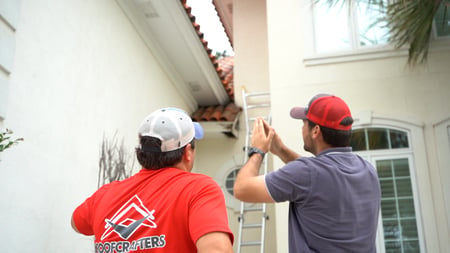Can a Bad Roof Make Me Sick?
April , 2025 | 5 min. read

When you think about your health, you probably don’t immediately think about your roof. Maybe you chalk up your recurring headaches, itchy throat, or that musty smell in the hallway to allergies, weather changes, or maybe even the dog.
But what if the real culprit is something above your head, literally? Let’s talk about an often-overlooked contributor to poor health: a failing roof. Yes, your roof. At RoofCrafters, we can tell you that the one job it has is to protect your home.
When it doesn’t do that job well, your home can become a breeding ground for problems that don’t just affect your walls and ceilings. They can also affect your body. So, can a bad roof actually make you sick? The short answer is yes. The long answer? Well, let’s get into it.
Leaks, Mold, and Unwanted Guests

A “bad roof” doesn’t have to be a catastrophic collapse or missing half its shingles to be dangerous. A few hidden leaks, some poor ventilation, or even years of neglected maintenance can be enough to open the door to health risks.
Water Leaks Lead to Mold and Mildew
One of the biggest red flags of a failing roof is water intrusion. When water seeps through your roofing system, whether it’s through cracked shingles, loose flashing, or compromised underlayment, it creates the perfect damp environment for mold and mildew.
Mold spores are everywhere in nature, but when they’re given a moist, dark, and humid indoor space (like your attic or ceiling cavities), they multiply. And fast. Black mold in particular can be toxic, causing symptoms such as:
- Persistent coughing or sneezing
- Throat irritation
- Nasal congestion
- Eye irritation
- Skin rashes
- Chronic fatigue
- In more severe cases: respiratory distress or neurological issues
What’s even more concerning is that many homeowners don’t realize mold is growing until they’re already sick.
Poor Ventilation Can Trap Toxins
Your roof isn’t just there to keep rain out. It’s part of your home’s ventilation system. If your attic or roof system doesn’t ventilate properly, moisture builds up inside, and your indoor air quality takes a hit.
Poor air circulation can increase levels of indoor pollutants, including volatile organic compounds (VOCs) from paint, cleaning supplies, and furniture. Over time, this trapped air can lead to dizziness, headaches, and long-term respiratory conditions.
Unwelcome Visitors: Pests and Pathogens
A damaged or deteriorating roof can also invite pests—think rodents, birds, and insects. These creatures can bring harmful bacteria, allergens, and even droppings that become airborne and end up in your lungs. Not exactly what you want floating around in your HVAC system.
How Your Roof Impacts Indoor Air Quality and Health

To understand how your roof affects your health, you need to think of your home as a sealed ecosystem. What happens in one part of the house, especially at the top, can trickle down into every other part.
It All Starts with Moisture
Moisture is your home’s enemy when it’s where it shouldn’t be. Roof leaks are one of the most common sources of excess indoor moisture, and once it gets inside, it doesn’t just disappear. It soaks into insulation, drywall, ceiling tiles, and wooden framing, all of which are highly susceptible to mold growth.
The tricky thing is, even a small leak can lead to major mold issues if it’s left untreated. That drip you ignored last rainy season? It could be contributing to the fuzzy green surprise behind your wall right now.
Air Quality Matters More Than You Think
According to the EPA, indoor air can be up to five times more polluted than outdoor air. If your roof is failing, your ventilation system can’t work properly, and toxins can’t escape. You’re essentially sealing yourself in with whatever allergens, bacteria, or contaminants are lurking inside.
Symptoms of poor indoor air quality include:
- Frequent colds
- Irritated eyes and nose
- Headaches
- Sleep disturbances
- Worsening asthma or allergy symptoms
If multiple family members are experiencing these issues and your HVAC system checks out, your roof may be the hidden cause.
Pests and Contamination
Roof damage often creates easy entry points for pests. A raccoon in your attic or mice sneaking in through gaps can bring in fleas, droppings, and disease. Their nesting materials can also block ventilation or contribute to fire hazards if they end up near electrical wiring.
Not only are pests disruptive, they’re dangerous to your health, especially for children, the elderly, or anyone with a compromised immune system.
What You Can Do to Protect Your Home (and Your Health)

So now that we know the link between a bad roof and your health is more than just theoretical, what can you do about it?
Schedule a Roof Inspection
If you haven’t had a professional roof inspection in the past year, now’s the time. Roofing contractors can spot damage you can’t see from the ground, and many offer free or low-cost evaluations.
Look for signs of:
- Shingle damage or missing shingles
- Soft spots or sagging in the roofline
- Stains or discoloration on your ceilings or walls
- Unusual attic odors or condensation
- Watermarks, peeling paint, or bubbling drywall
Address Leaks Immediately
Waiting to fix a leak is like ignoring a cavity; it only gets worse. Small leaks can lead to major structural and health issues, and quick action is key to keeping costs (and consequences) down.
Improve Your Ventilation
Talk to your contractor about your roof’s ventilation system. They may recommend ridge vents, soffit vents, or even attic fans to improve airflow and reduce moisture buildup.
Remove Mold Professionally
If you’ve found mold, don’t DIY it unless it’s extremely minimal. Hire a licensed remediation professional to ensure it’s safely removed, and then fix the root cause (usually your roof or insulation).
Replace the Roof If Necessary
Sometimes, patching won’t cut it. If your roof is more than 15–20 years old and showing widespread signs of failure, a full replacement may be your best (and healthiest) bet.
Don’t Forget Routine Maintenance
Clean your gutters, trim overhanging trees, and check for signs of wear every season. Preventive maintenance goes a long way toward keeping your roof (and your body) in good shape.
Your Roof is More Than a Shelter; It’s a Health Protector
Most people don’t connect the dots between their sniffles and their shingles, but the science and the symptoms don’t lie. A roof in disrepair can absolutely make you sick, and in more ways than one. Whether it’s mold, poor air circulation, or pest-borne bacteria, your roof plays a bigger role in your daily wellness than you probably imagined.
If you’ve been feeling a little “off” and can’t figure out why, look up. Your roof may be trying to tell you something. And if you need help figuring out what it’s saying, you know where to find us. Be sure to hit that “Schedule an Inspection” button down below!
My name is Cassie, and I’m the Content Manager here at RoofCrafters. I was born and raised in Chicago, Illinois, and made my way out to Florida post-college graduation. I’m incredibly passionate about writing and creating valuable content that helps others with the collaboration of my marketing team. When I’m not working, I enjoy shopping (a little too much), spending time at the beach, and reading!


